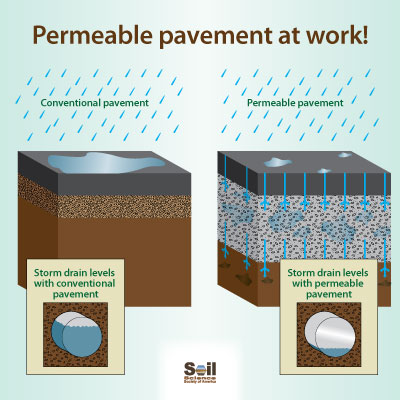Soil Science Society of America
5585 Guilford Road • Madison, WI 53711-5801 • 608-273-8080 • Fax 608-273-2021
www.soils.org
Twitter | Facebook
NEWS RELEASE
Contact: Hanna Jeske, Associate Director of Marketing and Brand Strategy, 608-268-3972, hjeske@sciencesocieties.org
What is “porous pavement” and how does that help soils capture and clean water?
Oct. 1 2018 – Parking lots, sidewalks, streets, and rooftops: cities are full of water-shedding surfaces. The Soil Science Society of America (SSSA) Oct. 1 Soils Matter blog explains why these surfaces are problematic, and how soil can be part of the answer.
 Impermeable surfaces, such as asphalt and concrete, move precipitation to storm drains, and from there to rivers, lakes, and oceans. But it’s not just water. Contaminants from cars and trucks wash away, as well as salts and other pollutants. All of that ends up in the watershed.
Impermeable surfaces, such as asphalt and concrete, move precipitation to storm drains, and from there to rivers, lakes, and oceans. But it’s not just water. Contaminants from cars and trucks wash away, as well as salts and other pollutants. All of that ends up in the watershed.
Bring back the soil, says Adrian Gallo, a doctoral student at Oregon State University. “One solution to this problem is to reconnect precipitation to the soil. Porous pavement allows water to filter through to the soil, using it as the natural and robust filter that it is!”
Porous concrete, asphalt, and pavers provide options for cities. They look like their non-porous counterparts, but have built-in void space. Water can flow through to a gravel-rock layer and then the soil.
“Porous pavement is a simple way to let water access the soil in areas that usually don’t let water infiltrate,” Gallo says. “Building parking lots or streets with the ability for water to pass through it helps minimize the cost needed for storm-drain infrastructure. They also decrease the amount of contaminants getting into surrounding river or streams, and help to replenish the aquifers and other groundwater sources beneath our feet!”
To read the entire blog post, visit https://wp.me/p3Rg6r-pC.
Follow SSSA on Facebook at https://www.facebook.com/SSSA.soils, Twitter at SSSA_Soils. SSSA has soils information on www.soils.org/discover-soils, for teachers at www.soils4teachers.org, and for students through 12th grade, www.soils4kids.org.